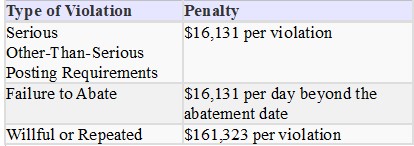
Job Safety Analysis (JSA) & Safe Operating Procedures Workplace Safety Program
This is a sample or partial document
Download the full customizable and printable version
General
Job Safety Analysis (JSA’s) is a process of determining physical requirements, environmental conditions and safety factors relating to a specific job or task. JSA’s are best used for stationary or repetitive production tasks or product movement, in which the job, equipment and work environment change very little.
Safe Operating Procedures (SOP’s) are written step-by-step procedures for a specific non-repetitive task which may be hazardous or critical. The purpose of an SOP is to provide written guidance for a particular task such that any qualified person can successfully and safely complete the task. SOP’s are best developed and used for highly skilled jobs and when the equipment and work environment change often. For example, an SOP with appropriate warnings and cautions, would best be developed and used for tasks such as confined space entry, maintenance tasks, lockout-tagout, welding operations, system startup and shutdown.
JSA’s/SOP’s provide
• PPE determination process
• Resource for supervisors to train new employees
• Control of job steps
• Identification and control of potential hazards
• Benchmark for accident investigation• Review of employee performance
Responsibilities
Management:
• ensure complete & effective JSA’s are developed for all production tasks
• ensure JSA’s are reviewed with new hires and annually thereafter
• utilize JSA’s and SOP’s in accident investigations and retraining
• ensure JSA’s & SOP’s are modified if a new step or process is added
• ensure SOP’s are developed for non-routine tasks that have a high degree of safety risk
Supervisors:
• use JSA’s and SOP’s to train all new employees
• use JSA’s and SOP’s when performing job performance evaluations
• develop and submit JSA’s for all tasks in their area of responsibility
• review JSA’s annually with all employees assigned to their department
The most important person in JSA process is the Supervisor, who is in constant contact with employees and should be familiar with the hazards in their Department. Supervisors are in a better position to recognize and correct unsafe acts and conditions as they occur.
Safety Coordinator:
• assist Management and Supervisors in developing JSAs and SOPs
• maintain a master file of all JSAs and SOPs
• ensure new JSAs or SOPs are developed for new equipment or processes
• ensure SOPs are posted for tasks that occur at fixed locations (i.e.. Bench Grinders, Boiler Operations, etc)
Documents
Forms and documents available for developing SOPs and JSAs are:
Job Safety Analysis Form
Job Safety Analysis Task Steps
Task Hazard Assessment Worksheet
Task Hazard Prevention & Control Worksheet
SOP Process
A Safe Operating Procedure consists of:
A written step by step procedure for a specific task
A description of possible hazards & cautions
Hazard Control steps
List of required personal protective equipment (PPE)
Qualifications required for the operation
SOP’s may be permanently posted or consist of multi-page instructions that are to be reviewed prior to each time a qualified person performs the task.
SOP’s are developed and completed by the following steps:
1. Draft Development of SOPs
2. Review and approval of SOPs
3. Implementation of SOPs
4. Review and updating SOPs
5. Periodic Training using SOPs
JSA Process
A Job Safety Analysis consist of:
1. Job Physical Requirements
2. Job Environmental Conditions
3. Personal Protective Equipment required
4. Sequence of Basic Job Steps
5. Potential Accident or Hazards associated with each step
6. Safe Job Practice for each step
Job Safety Analysis are completed through the followings steps:
1. Development of JSA’s
2. Review and approval of JSA’s
3. Implementation of JSA’s
4. Review and updating JSA’s
5. Periodic Training using JSA’s
Development of JSA/SOP
There are many ways to develop JSA/SOPs, however, observation and team approach has proven the most reliable. By watching the tasks, the observer can see first hand what is required, recognize the hazards and recommend alternatives. Below is the sequence used to develop a JSA/SOP:
1. Select the most experienced employee to observe
2. Explain the purpose of your observations
3. Observe the task and define the steps used to complete the assignment
4. Record the basic steps
5. Review the steps with the observed Employee for clarity
6. Observe the task a second time and identify any hazard potentials and record the findings. Hazard types include:
Impact
Contact with Chemicals
Caught on or between
Lacerations
Burns
Fall or Slip
Over exertion
Cumulative Trauma
7. Observe the task a third time to develop corrective measures to all

GET INSTANT ACCESS
to THE MEMBERS LIBRARY
Safety materials created by safety professionals.
Access to the Safety Manager software.
Wide variety of safety videos and courses.
**Brand New** Safety Training Management System
Pre-Made Safety Materials Ready For Use
Created by experienced safety professionals & risk consultants. Saving you time, money, and risk of injuries.
95% of the work already done.
Below are the maximum penalty amounts, with the annual adjustment for inflation, that may be assessed after Jan. 15, 2024. (See OSHA Memo, Jan. 8, 2024).

**New OSHA HEAT 90 DAY**
>>Download Free HERE<<
**New 2024 OSHA 300 Form**
>>Download Free HERE<<
**Brand New**
Free with full membership subscription
Training LMS System
Ask The Safety Consultant
Safety Equipment Deal Finder

“SafetyInfo.com is the first go-to website for safety professionals and companies to use in establishing a solid safety program"
-Mike McKenzie, Certified Safety & Health Manager (CSHM), McSafety Solutions™
Note: You must have a full subscription to the Safety Library in order to use this material. Any use outside of your organization, for resell, or without an active membership is strictly prohibited and may result in prosecution under copyright infringement laws. Please contact us first, if you would be interested in reselling or using our materials for reproduction.
Inside the Members Library
Topic Index
Accident Prevention
Air Quality
Asbestos
Bloodborne Pathogens
Boilers
Chemical Safety
Compressed Gas
Confined Space
Construction
Construction Worksite
Cranes & Slings
Driver / Fleet Safety
Drug Free Workplace
Electrical
Emergency Management
Engineering Safety
Environmental
Equipment
Ergonomics
Fall Protection
Fire Safety & Prevention
First Aid
Flammable Materials
Forklifts
Hazard Communication
Hazardous Materials
Hearing Protection
Heat Stress
Hot Work
Housekeeping
Job Safety Analysis
Laboratory
Ladders
Lead
Lockout-Tagout
Machinery & Equipment
Material Handling
MSDS (SDS)
Medical & First Aid
Occupational Health
Office Safety
Off the Job Safety
Personal Protection
Process Safety
Record Keeping
Respiratory Protection
Silica Safety
Rules & Policies
Signs & Labels
Slips, Trips & Fall
Training
Terrorism Programs
Tool Safety
Vehicle & Driver
Violence Programs
Welding & Hot Work
Training Videos
Library Index
Training Materials
Videos/Courses
Talks
Articles
PowerPoint
Handouts
Training Overheads
Quizzes
Supervisor Briefs
Management Briefs
Safety Sessions
2 Minute OSHA Safety Talks
Pamphlets
First Aid Training
Supervisor Training
Hazardous Materials
Bomb Threat
Crossword Puzzles
Biological Agents
Forms & Documents
Forms
Checklists
Audit Guides
Inspections Guides
Signs & Labels
Environmental Audit Guides
Recordkeeping - OSHA 300
Sign & Label Maker
Safety Management Resources
Safety Manuals/Written Programs
Ergonomic Programs
Emergency Plans
Process Safety Management
Construction Safety
Occupational Health
Environmental
Topic Sheets
DOT Fleet-Driver
Hazardous Materials
Chemical Safety
Drug Free Workplace
Terrorism Programs
Development Guides
Safety Manager Software
Safety References & Graphics
Technical Safety Information
Posters
Topic & Fact Sheets
Development Information
Job Specific Safety Rules
Terrorism
Calculators
Safety Comic Strips
New Safety Training System
Schedule and train your employees with our materials. Add unlimited amount of employees. Record all progress and issue certificates. For group and individual training sessions.

